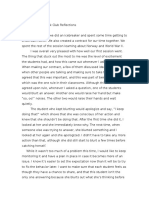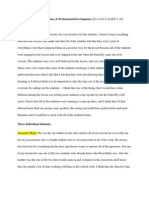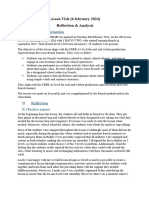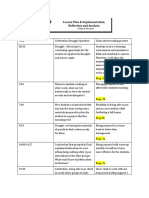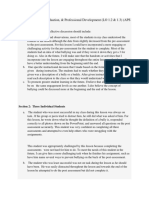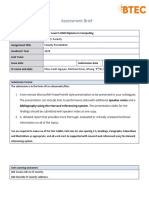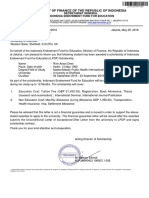The Reflection
Throughout my lesson, the only thing that I feel went differently than originally planned is the timing
and pacing of the lesson. I definitely think that I could’ve been a lot better with time and making sure I was
not taking too long on certain aspects of the lesson. At the end we got a little bit rushed to finish and went all
the way up until the last minute before dismissal. Now this does tend to happen frequently with this group
just because we have a little bit less time with them than we do our first group. To ensure everything gets
done and we don’t fall behind we try to utilize all the time we have. But even with going to the end I still was
not able to do as much as I did with the first group. For example, with the character matrix activity, with the
first group we were able to go over the whole thing but with the second class I wasn’t able to do that so I just
picked the main important ones to go over that I felt would help them understand the story and help them
with their exit ticket the most. Overall, I think I just didn’t fully take into account the fact that I have a little
less time with the second group so I was pacing the lesson the same way that I did for the first group and that
pacing just didn’t really work with the second group.
If I was going to do this lesson again with the same group of students, I would make sure to take that
half hour time difference into consideration in order to better pace the lesson for this second group of
students. Another thing that I would do differently is with my procedures. I would like to develop a better
system for calling students to the carpet. We don’t go to the carpet that often and the students have to stay in
their table groups because of COVID. So, I think the students still get a little bit confused about where they’re
supposed to be sitting on the carpet. Another thing I would do differently is to go over expectations for
behavior before we start the lesson because this group in particular has a bit more trouble with behaviors
such as calling out, not giving me their full attention, and being chatty. Also, this group has a lot of very strong
personalities which isn’t a bad thing, but it can make it more difficult to manage their behaviors. I think they
just need very explicit reminders both at the start of class and before each activity.
The thing that surprised me the most about my lesson is how well the students were participating
and working with each other. I even had two boys, who typically have trouble getting along with people,
working together very nicely. As I was walking around room and also during our turn and talks I heard the
students having great discussions and they really seemed interested in what we were reading. This surprised
me because this group in particular has trouble staying on task as they are very chatty and easily distracted.
They also sometimes struggle working together nicely. As I said there are a lot of strong personalities in this
group so sometimes they struggle working together. I also noticed that there were a lot of students, who
normally don’t participate that much, raising her hand to answer questions which make me happy. I always
try to call on these students a lot because I want them to gain some confidence when it comes to answering
questions in class.
The main a counter that comes to mind is when the two boys who are typically off task and don’t get
along with their peers were answering questions and working together nicely. Although I did have to remind
them on multiple occasions that they need to raise their hand to speak and not call out, I was surprised that
they were answering questions at all and following along with what we were talking about. These two boys
were sitting next to me so it was easy for me to manage their behaviors. I also think that them not being in the
middle of the group lessened any distractions for the other students at the carpet. Also, the fact that they
wanted to work together confused me at first because they do not typically like working with others. Most of
the time students have to stay in their table groups and work with their peers at their table. But, I decided to
make an exception for these two boys because they were working well together.
During my lesson I feel I demonstrated a lot of different FEAPs and I could tell that I have grown as a
teacher. In particular, I demonstrated FEAP 3B: Deepen and enrich students’ understanding through content
area literacy strategies, verbalization of thought, and application of the subject matter. One way I did this was
during minute 25:30 from part one of my video. In this moment, before we started reading our story I made
sure to give the students a purpose. I instructed them to follow along and underline parts of the text that
discussed characters and their traits. Underlining key information as you read an important strategy for
reading. Something else I did was verbalize my thoughts as a way to model. I would then ask the students to
�verbalize their thoughts as I was asking them questions. Another FEAP that I demonstrated in this lesson was
3i: Support, encourage, and provide immediate and specific feedback to students to promote student
achievement. I did this at minute 30:34 in part 1of my video when during the turn and talk I talked with two
boys who typically have trouble participating in partner/group activities. One of the boys in particular has
very low confidence in his abilities and so I wanted to show support and encouragement during the turn and
talk to get them engaged in the discussion. I can also make a connection to an improvement that I made while
teaching this lesson with the second group. A note of feedback my CT gave me after my lesson with my first
group of students was to utilize more turn and talks and checks for understanding. This is something I feel I
implemented better for this second group. I think the use of these strategies connects to FEAP 3g. Apply
varied instructional strategies and resources, including appropriate technology, to teach for student
understanding;
The Analysis
Out of the 16 students in class this day, 5 of them fully met the objective. 7 of them partially met the
objective, and 4 them did not meet the objective. After looking at the exit tickets for the kids who partially met
the objective, I could see that most of them picked a correct character trait for the character it was asking
about, but what they struggled with was their evidence. They were not picking the relevant details when
describing how they know that the character has that trait. There were four students who did not meet the
objectives based on the exit tickets, out of those four, two of them turned in their exit tickets blank. Based on
my discussions and observations during the lesson, I could clearly see that these two students were
struggling a bit with implicit characteristics which was what the exit ticket was asking about. For both of the
students I even circled in the text which paragraph they needed to look in to help them answer the question
and they still both turned it in blank. I think for my students who didn’t meet the objectives they would have
benefited more from working in a small group with the teacher than working whole group as we did this day.
Also, I think if I would have modeled a bit more how to use implicit details to determine character traits that
would have helped. For my students who met the objective or partially met objective I think they benefited a
lot from the turn and talks and group work because if the way I was explaining things wasn’t clear, they had
their peers to talk about it with and possibly explain it in a different way.
As far as special considerations of accommodations for students, I have a couple students with 504
plans, one of which was not in class on this day. For another student with a 504 plan, I allowed her to stay in
her seat instead of making her come to the carpet while we were reading the story. I also let her do the
activities in the lesson at her own pace and did not rush or force her to complete anything. I allowed her to
just listen and do as much as she could in that moment. I also have a few ELL students in this class and so I
made sure to provide some accommodations for them. The differentiated exit tickets I used were helpful
because they provide sentence stems to help them with answering questions. I also made sure to repeat
directions to them at least once. Another thing I did for them is I frontloaded a lot of vocabulary and put it
into simpler terms. As far as these students go with meeting the objective. For my students with a 504s, who
were in class, one met the objective and the other did not. For my ELL students of the ones who were there in
class, one met the objective, 3 partially met the objective, and one did not meet the objective. One of the
reasons why some of these students had trouble meeting the objective is because while they understand
character traits and how to name them when they are explicit in the text, they do not always understand
when the traits are implicit.
Based on what happened in this lesson, the steps for the next day were to continue reading the story
to determine the theme. This next day, we reviewed what we did and then based on the exit tickets from this
day, my CT held a small group while I taught the rest of the students whole group. This next day, after reading
the rest of the story we filled in a graphic organizer called “steps to finding the theme”. This graphic organizer
asked students about characters in the story, their character traits, the problem in the story, how the
characters solved the problem, how the characters change, and what the characters learned. These are all
valuable questions to consider when determining a theme. Because theme can be difficult and this was
basically our first time really talking about it in depth, I decided that it would be best for us to do the graphic
organizer together and then the only thing the students had to on their own was determine the theme based
�on the work that we did together. I then used the information gathered on day 2 for lessons the next week as
we were still discussing themes.
Below are images of some the exit tickets that the students turned in. The + means they met the
objective, the + with a circle around it means they partially met the objective, and the – means they did not
meet the objective.
Content-Focused Questions
During this lesson I addressed multiple pillars of a literacy instruction in different ways. With
fluency I modeled to the students what being a fluent reader sounds like. I stopped for punctuation, I read
with expression, I read at a proper pace, and I read with accuracy. I addressed comprehension by stopping
at certain points in the story to ask the students questions about what we were reading that related to our
objective. I allowed them to turn and talk during certain questions so they could hear each other’s
thinking. Another thing I did for comprehension was the character matrix activity and the exit tickets.
Both of these were meant to get the students to really think about what we read and more specifically
about the characters in the story. Being familiar with the characters was also going to help as we continue
the story the next day to find the theme. Being able to talk things out and answer questions about the story
all aids in comprehension. As far as vocabulary I addressed this in a couple different ways. I started the
beginning of the lesson with a peek into some of the vocabulary that was important to the story and the
genre of folk tales. At the beginning, the students were able to talk about what that vocabulary meant and
how it could relate to the story that we would be reading. Then, as we were reading I made sure to stop at
certain words in order to tell the students what they meant. This also aided in comprehension because the
students weren’t spending too much energy trying to decode what some of the words meant. This is
especially helpful for my lower level readers and ELL students who need the vocabulary to be
frontloaded and put it in simpler terms.
The reason I did the vocabulary discussion in the beginning of the lesson was to get the students
engaged about what we were learning. I picked words and pictures that were not only important to the
story and the genre, but that would also engage the students and get them interested. Other vocabulary
�words that I went over a lot where the words explicit and implicit. I made sure two keep referring back to
these words as they were important for not only our standards this week but also for in the future. These
are words that the students will be hearing a lot in ELA questions and prompts. I also first addressed
comprehension very explicitly by allowing them to think about answers they could find explicitly in the
text. Then, I asked them about things that were implicit in the text. I also gave them opportunities to talk
and discuss with their peers around them. That way if any students were struggling with comprehension
they could talk it out with a peer first before we went over it whole group. The differentiated exit tickets
were also a way for me to assess their comprehension and if they met the objectives.

